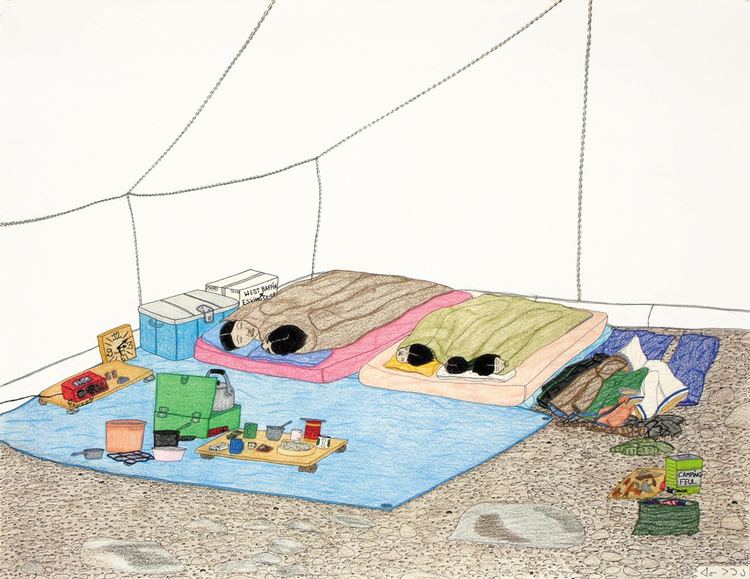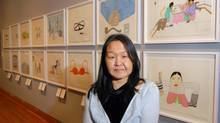Nationality Inuit, Canadian Awards Sobey Art Award2006 | Name Annie Pootoogook | |
 | ||
Born May 11, 1969 ( 1969-05-11 ) Cape Dorset | ||
Inuit artist annie pootoogook
Annie Pootoogook (May 11, 1969 – September 19, 2016) was a Canadian Inuk Artist known for her pen and coloured pencil drawings. In her art, Pootoogook often portrayed the experiences of those who lived in her community of Cape Dorset (Kinngait), in Northern Canada and occurrences that she herself experienced.
Contents
- Inuit artist annie pootoogook
- Remembering annie pootoogook aptn news
- Early life and education
- Artistic career
- Subject matter
- Style
- Dr Phil
- Recognition and awards
- Collections
- Death
- References

Remembering annie pootoogook aptn news
Early life and education

Annie Pootoogook was born on May 11, 1969 in Cape Dorset (Kinngait), Canada. Pootoogook grew up in a middle-class family whose wealth came primarily from their artistic practices. Her family worked in multiple mediums and styles and Pootoogook became interested in art at an early age. Her mother Napachie Pootoogook was an Inuk draftswoman and her father Eegyvudluk Pootoogook was a printmaker and stone sculptor. Pootoogook was the granddaughter of Pitseolak Ashoona a renowned graphic artist, the niece of printmaker Kananginak Pootoogook and the cousin of draftswoman Shuvinai Ashoona.
Artistic career

Pootoogook began making art in 1997 at the age of 28. She worked with the West Baffin Eskimo Co-operative (previously known as Kinngait Studios) in Cape Dorset, Nunavut. In her early career with the Co-operative she was not given any artistic freedom.

The 2000s were Pootoogook's most productive years. It was between 2001 and 2007 that Pootoogook was the most prolific in her art making. She worked as an independent artist during this period, leaving the West Baffin Eskimo Co-operative in 2001. During this time, she drew intimate home interior scenes depicting alcoholism, violence, and domestic abuse, the everyday experiences of a women living in the Canadian North, the hardships faced by Northern communities, and the impact of technology on traditional Inuit life. Pootoogook solidified her style and content during this period beginning to draw images that could be easily attributed to her. She created over 1000 works on paper and it was during this time that she began to be recognized as an artist outside of the Inuit community.
Pootoogook had a small exhibition in 2003 at The Feheley Art Gallery. This was her first solo exhibition and was important for her career because it made her name more widely known.
Subject matter
Pootoogook was known for her drawings created in pen and coloured pencils that depict contemporary Inuit life. Inuit life and experiences influenced her career immensely, providing her with the subject matter that she would later render. Her work primarily focused on three subject types: the everyday experiences of women living in the Canadian North, the hardships faced by Northern communities and the impact of technology on traditional Inuit life. In addition, her work often juxtaposes intimate home interior scenes with scenes of alcoholism, violence, and domestic abuse – lessening the safety of the home.
Her work is largely inspired by her mother Napachie Pootoogook and her grandmother Pitseolak Ashoona, both of whom are well known Inuit artists. Like her mother and grandmother, Pootoogook worked in the Inuit tradition of sulijuk which means “it is true.” This means that she depicted life as she saw it without adding too much of her hand into the composition.
Pootoogook is noted for titling her work for exactly what they depict, e.g. “Man Abusing his Partner”, where a man is shown abusing his wife.
Style
Pootoogook's compositions utilized simple line drawings with figures posed in frontal or profile views. Her interior scenes line up with the picture plane, yet have simple perspective that does not rely on trueness to nature. Her images tend to have large expanses of white space and her colour schemes are often muted, lacking vibrancy. Her work has been described as "rudimentary"' and "child-like" as it does not maintain any realism of form or space.
Pootoogook often included clocks in her work which has made them a motif that is associated with her work and allows for easy attribution. Her work captures a moment in time which is an important theme to Pootoogook. It is unknown why time plays an important role in Pootoogook’s work. Nevertheless, the clock motif has been agreed upon by scholars to be artistically important to her work.
Pootoogook’s compositions are not reproducible which acts against traditional printmaking practices of Inuit art in which copies are made to be sold and dispersed. Therefore, her work is not as widely represented as there is only one original copy of each work.
Dr. Phil
Annie Pootoogook's most notable work is Dr. Phil, which shows a young girl watching the American television show by the same name in her home in Kinngait, Nunavut. This composition is an archetypal drawing by Pootoogook which shows the influence of Western technology on Northern communities. It also includes the clock motif, and appears in a similar style to Pootoogook’s other works. Pootoogook’s use of a popular television personality made this composition well-liked in its own right. Traditionally, Inuit art often shows typical activities of Northern communities such as hunting, fishing and spiritual gatherings. Her use of non-traditional imagery appeals to contemporary art collectors who often are not interested in traditional Inuit art or practices of living.
Recognition and awards
Pootoogook had her first major solo exhibition in 2006 when her work was displayed as part of a well-received show at The Power Plant in Toronto, Ontario. The exhibition, designed by Nancy Campbell, focused on mythology, Inuit communities and difficulties of life in the Arctic.
In November 2006 she won the Sobey Art Award and was granted the prize of $50,000 (CDN). The Sobey Award is granted to an artist who is 39 years of age or younger and has shown their work in a public or commercial gallery in Canada in the past 18 months, at the time of their application. The press release announcing Pootoogook's win noted that "her work reflects both the current moment of a specific tradition and of a contemporary drawing practice."
After winning the Sobey Award she continued to receive exposure. She exhibited in major art shows such as the Biennale de Montreal, Art Basel and Documenta 12. Pootoogook was the first Inuit artist to participate in Documenta – an exhibition of contemporary art held in Kassel, Germany.
From 2009 to 2010 her work was shown in solo exhibitions at multiple galleries including the Agnes Etherington Art Centre (Kingston, Ontario), the National Museum of the American Indian (Washington, D.C.) and the George Gustav Heye Centre (Manhattan, New York). In 2010 her work was also exhibited at the Biennale of Sydney.
Pootoogook participated in one her last exhibitions in 2012 at the Massachusetts Museum of Contemporary Art. Curated by Denise Markonish, the exhibition titled Oh, Canada, showcased 62 Canadian artists including the work of Pootoogook's cousin Shuvinai Ashoona Pootoogook was the only professional artist from the Ottawa region represented in the exhibition.
Collections
Annie Pootoogook is represented by the small Toronto gallery, Feheley Fine Arts. They are the gallery primarily responsible for cataloguing and selling her work.
Annie Pootoogook’s art began to be widely collected by Canadian art institutions in 2006 after she won The Sobey Award. The Art Gallery of Ontario (Toronto, Ontario), The National Gallery of Canada (Ottawa, Ontario), and Feheley Fine Arts (Toronto, Ontario) all hold significant collections of Pootoogook’s work.
Death
Pootoogook was found dead in the Rideau River in Ottawa on September 19, 2016.
Her body was sent back to Cape Dorset where a funeral was held in her home village. The service was performed entirely in her native language of Inuktitut. Pootoogook’s youngest daughter was able to go the funeral and this was the first time she met her extended Inuit family.
After her death, the lead investigator on the case, Sergeant Chris Hrnchair posted online comments that were condemned and labelled as racist. An investigation into Hrnchair’s conduct was undertaken as a result. In November 2016, Hrnchair pled guilty to two counts of discreditable conduct under the Police Services Act, and for making comments on an open investigation.
In 2017, Hrnchair met with Veldon Coburn an Anishnaabe scholar who had initially documented Hrnchair's original online comments with a screen capture. Coburn filed a complaint leading to the charges against Hrnchair and his demotion. Wanting to apologize for his comments, Hrnchair asked for a meeting with Coburn stating "I'm blessed to be able to see you, to apologize to your face because I know how much it's hurt your community and the people you love." Coburn stated that he was moved by the gesture and believed that Hrnchair was sincere in his remorse.
